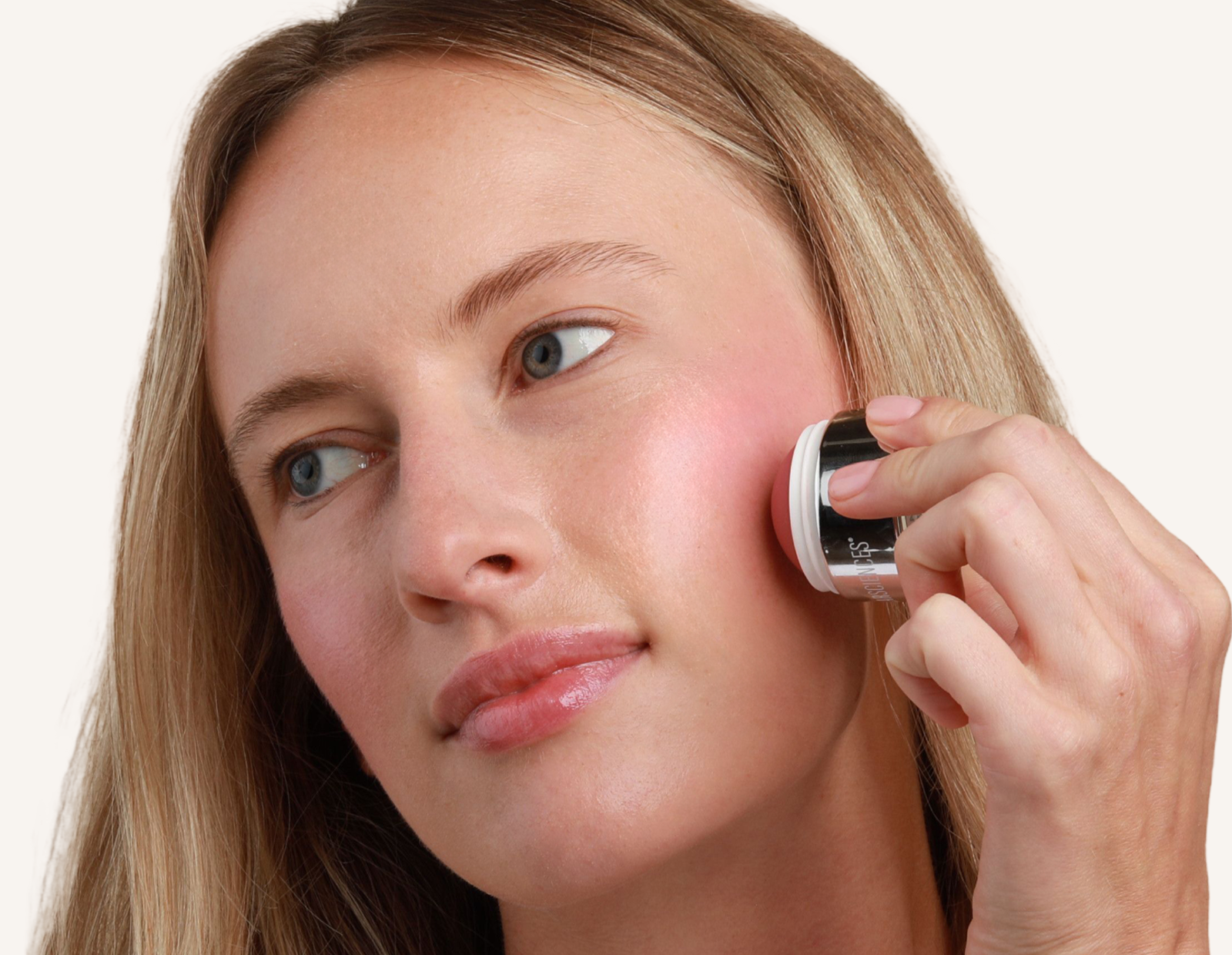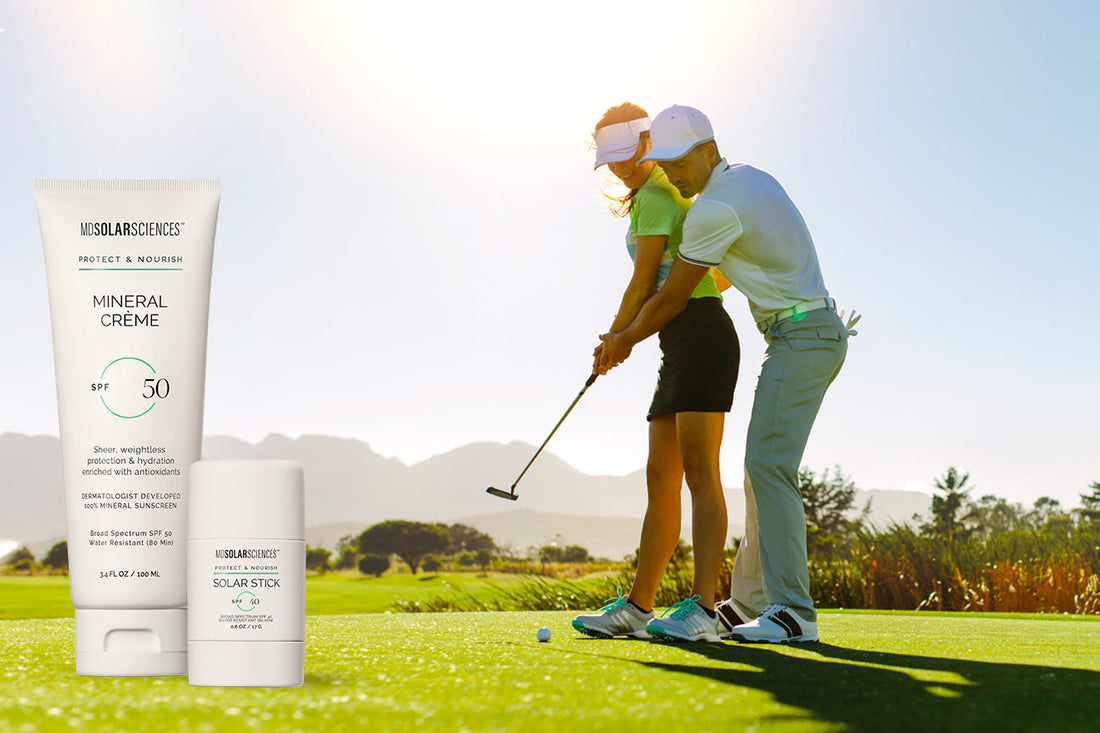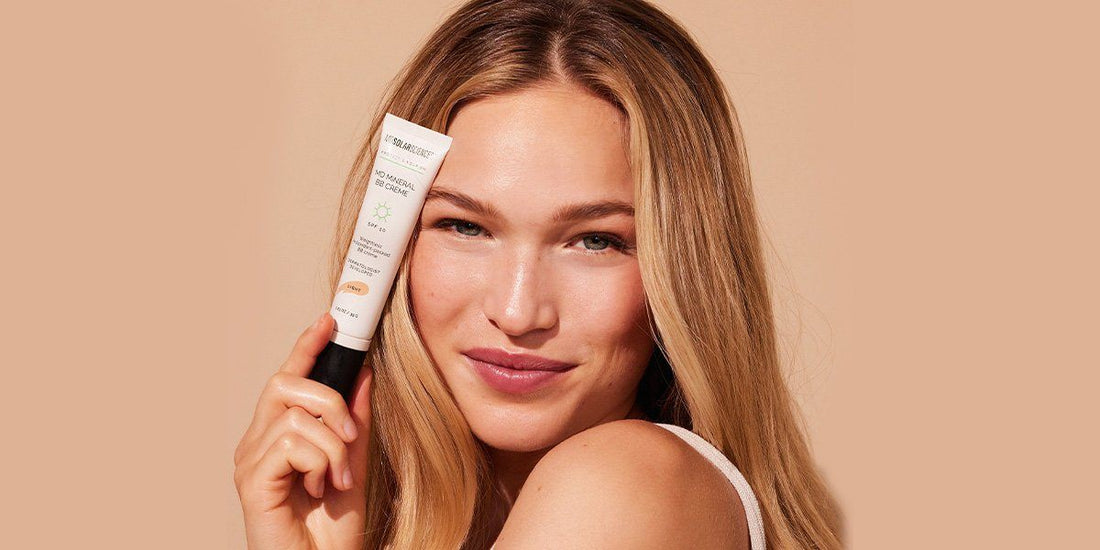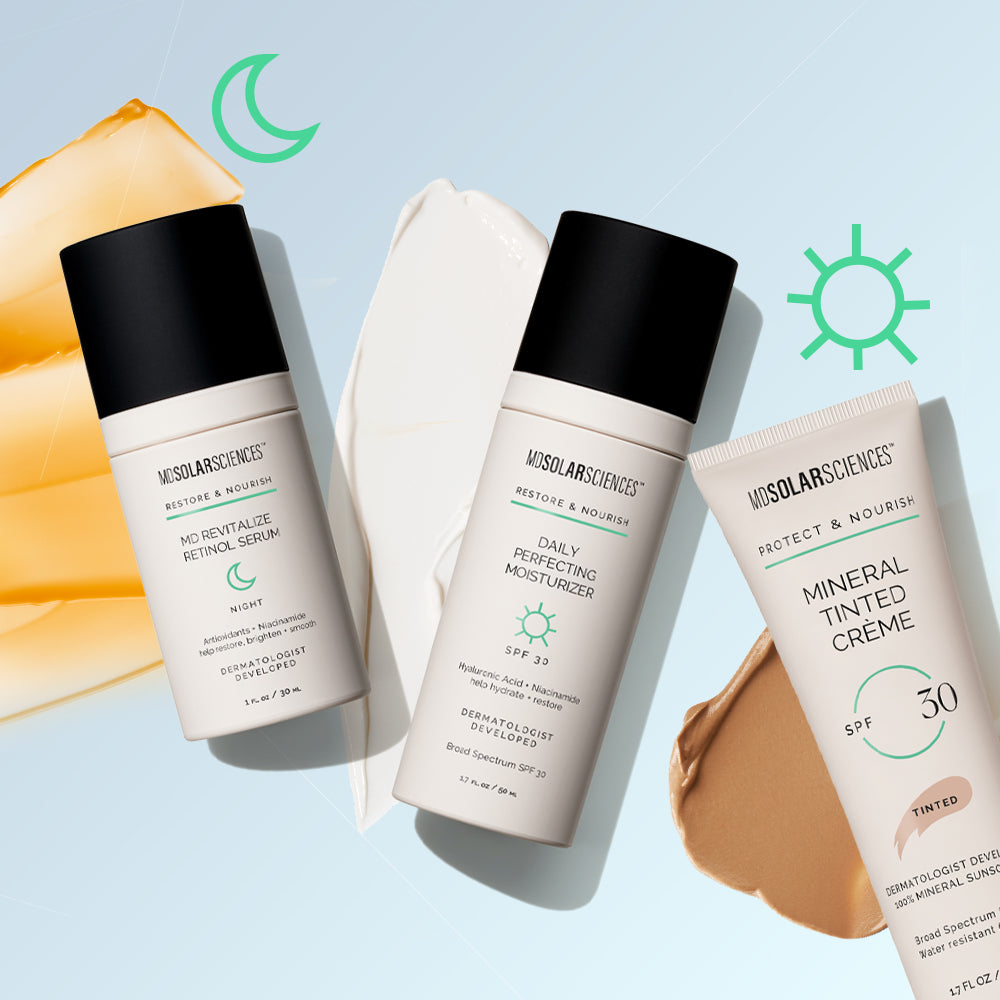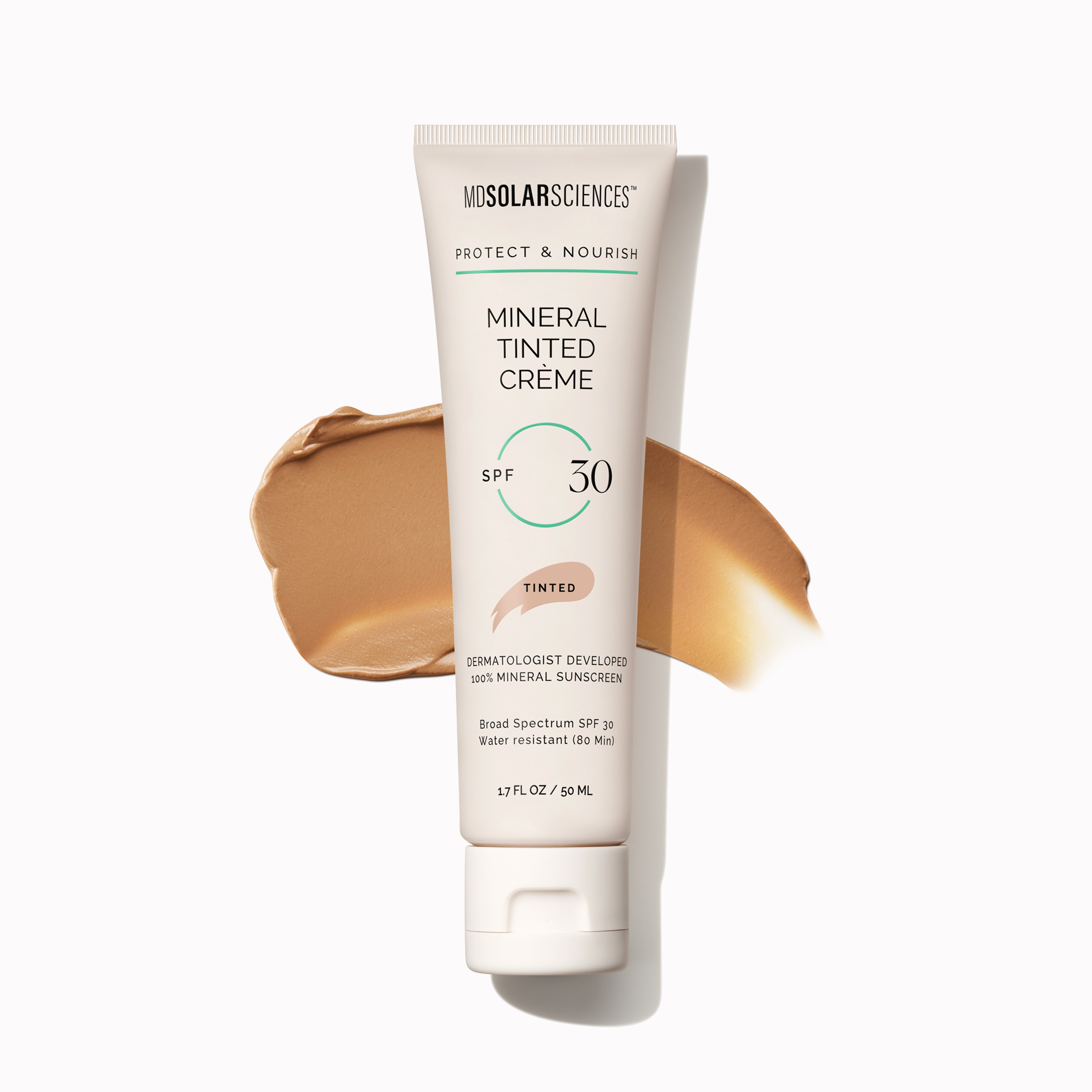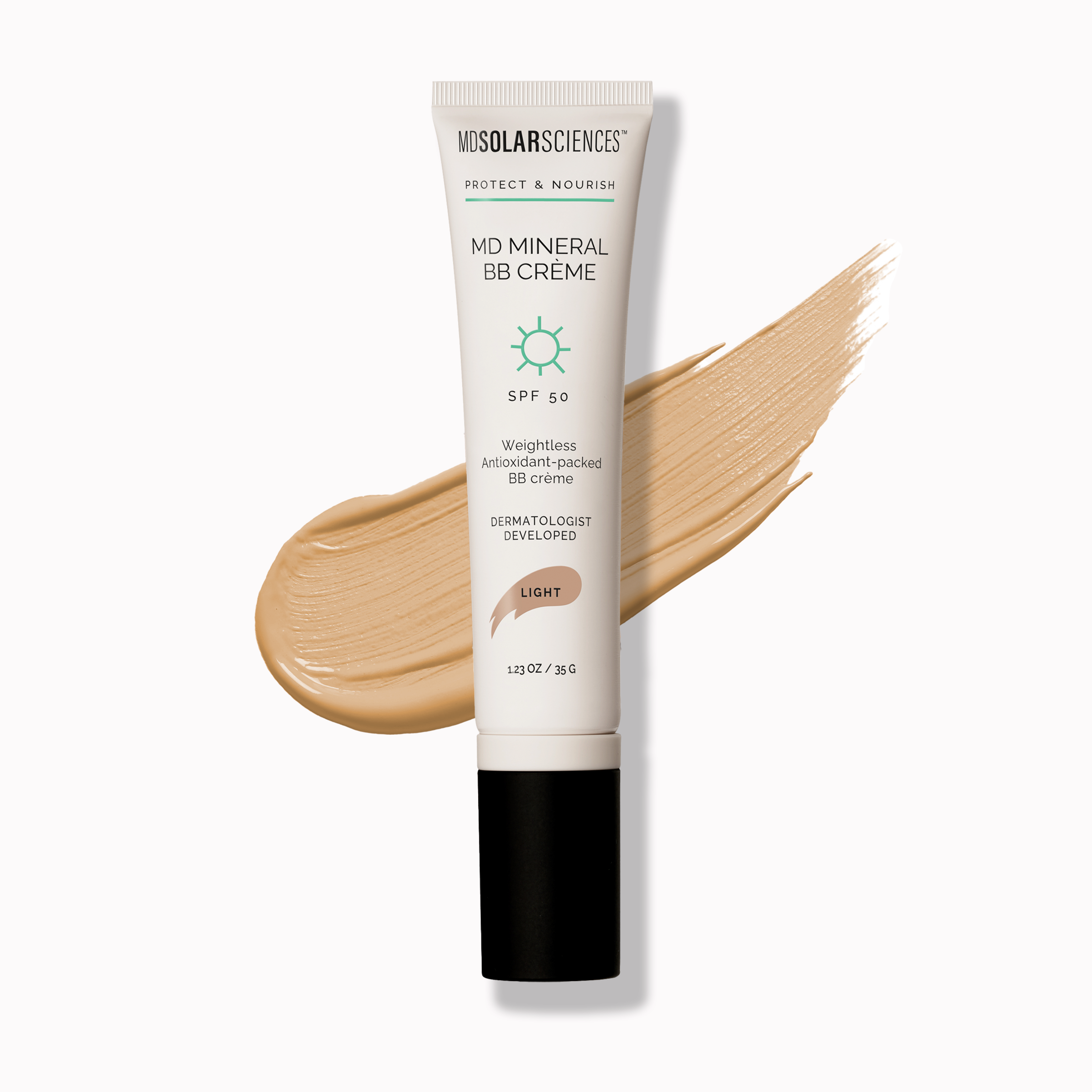Blog: Everything Under the Sun
Is Natural Tanning Bad for You?
Let’s settle this for good: a tan isn’t “healthy color.” Not even a little. A light tan might look radiant, but what you’re seeing is your skin responding to UV damage. When UV exposure hits, melanin production spikes in self-defense—darkening the skin to try to prevent even more injury. That golden-hour glow people chase? It’s a red flag, not a wellness win. The good news: you don’t need UV damage to get that luminous look. Tinted sunscreens, daily moisturizers with SPF, and modern makeup alternatives deliver believable, healthy-looking radiance—minus the risk. So go ahead, glow smarter and keep your skin protected.
Learn moreSun Damage: Beyond Wrinkles
Sun damage affects more than just your skin’s surface. While wrinkles are the most visible sign, UV exposure also harms collagen, disrupts your skin’s immune defense, triggers dark spots, changes texture, and can even damage DNA, increasing the risk of skin cancer. UVA rays penetrate deep and cause aging, while UVB rays burn the surface. Prevention is key: daily broad-spectrum sunscreen (SPF 30+), reapplication, and coverage of often-forgotten areas like eyes, lips, and hands protect both appearance and health. Modern formulas, including tinted and mineral options, combine UV protection with hydration and antioxidants to defend, correct, and restore skin. Consistent sun care preserves skin’s firmness, radiance, and long-term health—because stopping damage before it starts is the smartest beauty move.
Learn moreThe SPF Matchmaker: Find Your Perfect Sunscreen by Skin Type
Overview: Not all sunscreens are created equal—and the wrong one can sabotage your skin. Whether you’re oily, dry, sensitive, or acne-prone, discover your SPF soulmate with dermatologist-developed formulas designed to protect, perfect, and actually feel good on your skin. The SPF Matchmaker: Find Your Perfect Sunscreen by Skin Type When it comes to sunscreen, most of us know the basics: apply broad-spectrum protection, reapply every two hours and don’t skip a day—even if it’s cloudy (yes, really). But here’s the thing, are you using SPF that’s best for your skin? Your skin type matters more than you think when it comes to picking the right formula. The Wrong SPF Can Sabotage Your Skin Sunscreens that feel like silk on dry skin might turn into an oil slick on oily skin. A formula that works wonders for acne-prone complexions could leave sensitive types red and irritated. It’s not one-size-fits-all, and honestly, why should it be? The good news: no matter your skin type, there’s an SPF soulmate destined to be your perfect match. Founded by dermatologists, MDSolarSciences really understands that your skin type should be factored into the sunscreen that you choose and use; and we’ve spent years perfecting formulas that work as hard for your skin as they do against UV rays. Consider this your guide to finding “the one.” Why Your SPF Should Swipe Right on Your Skin Type Think of sunscreen as the ultimate multitasker. It’s the non-negotiable daily step that protects against sunburn, premature aging, hyperpigmentation, and even skin cancer. But beyond that, it’s also skincare. The right SPF should elevate your daily routine, not work against it. Here’s what happens when your SPF isn’t a good match: Oily skin: heavy formulas = clogged pores and extra shine. Dry skin: matte or oil-free sunscreens can leave your complexion parched and flaky. Sensitive skin: chemical filters may trigger stinging or redness. Acne-prone skin: greasy or comedogenic formulas can fuel breakouts. Translation: the wrong sunscreen can play havoc with your skin. But don’t stress, read on to discover formulas you’re sure to fall in love with. For Oily Skin: Stay Shine-Free & Fabulous Oily skin gets a bad rap, but here’s the upside: all that natural moisture keeps skin plumper and younger-looking for longer. The challenge? Shine, clogged pores, and breakouts. What to look for: Lightweight, oil-free, or gel-based formulas Non-comedogenic (translation: won’t clog pores) Matte or soft-focus finishes to counter shine MDSolarSciences Pick: Mineral Crème SPF 50 This cult-favorite formula feels like cashmere on your skin and dries to a natural matte finish—no greasy residue, no pore-clogging oils. The naturally derived zinc oxide protects against UV rays, while antioxidants like Vitamin C go the extra mile to fight free radicals. It’s basically SPF with a built-in Instagram filter. Pro tip: If you get shiny mid-day, keep blotting papers handy, but resist the urge to powder over your sunscreen. That can mess with your protection. Instead, reapply with a portable stick formula. Dry Skin: Quench Its Thirst If moisturizer disappears on your skin faster than you can say “reapply,” you need SPF that works double duty to keep hydration locked in while defending against the sun. The wrong sunscreen can suck away what little moisture you have left, leaving your skin feeling tight, flaky, and uncomfortable. What to look for: Creamy, hydrating textures Moisture-boosting ingredients like vitamin E or hyaluronic acid Sunscreens with a dewy finish MDSolarSciences Pick: Mineral Tinted Crème SPF 30Sunscreen that feels like skincare, it’s silky, moisturizing, antioxidant-packed, and has just the right amount of tint to blur and even out skin tone. Translation: your dry skin gets a healthy drink of hydration and that dewy, lit-from-within glow. Pro tip: Apply SPF as the last step in your routine over your moisturizer, not instead of it. Layering hydration is key for parched skin. Sensitive Skin: Handle With Care If your skin flares up at the mere mention of a new product, don’t worry… we’ve got you. Chemical filters can sting, fragrances can irritate, and heavy formulas are a recipe for redness. The good news: mineral sunscreens are your sensitive skin’s BFF. They use zinc oxide and titanium dioxide to physically block rays, and they’re far less likely to irritate your skin. What to look for: 100% mineral formulas (zinc oxide + titanium dioxide = gentle heroes) Fragrance-free, soothing, minimalist ingredient lists Formulas that feel so great you’ll actually want to wear them every day MDSolarSciences Pick: Solar Stick SPF 40Kid-safe, (aka, gentle) fragrance-free, and gentle enough for even the most easily irritated complexions. This on-the-go stick glides on seamlessly, no stinging, no burning. Bonus: it’s also portable, so you can reapply at a moment’s notice. It’s a sensitive skin win. Pro tip: Always patch test, even with mineral sunscreens. A quick dab on your jawline can save you from a full-face freakout.Acne-Prone Skin: Breakouts BewareThe last thing acne-prone skin needs is another reason to break out. Unfortunately, the wrong SPF can do just that, clogging pores, adding grease, or suffocating skin. The right one? Game-changer. What to look for: Oil-free, lightweight textures Non-comedogenic (aka, won’t clog pores) Mattifying finishes with calming ingredients like niacinamide or green tea MDSolarSciences Pick: Tinted Solar Stick SPF 40Portable and sheer, this SPF stick won’t clog pores, but it will protect your skin while blending seamlessly into your complexion. It’s antioxidant-rich to calm inflammation and compact enough to slip into your pocket. Goodbye blemishes, hello protection on-the-go. Pro tip: Never skip SPF because you’re anxious about a breakout. Fact: sun exposure can darken acne marks and make them linger, so be sure to wear it every single day. The Perfect Product Is Just The First Step Once you’ve found your SPF soulmate, here are some non-negotiables everyone should follow—no matter your skin type: Reapply, reapply, reapply. Every two hours if you’re outdoors, and more often if you’re swimming or sweating. Don’t skimp. Most people under-apply sunscreen. You need about a nickel-sized dollop for your face and a shot-glass amount for your body. Layer smart. Sunscreen goes on last (before makeup). If you’re using serums or moisturizers, let them sink in first. Don’t miss these important bits. Ears, lips, scalp part, hands, and feet. Check the expiration. Sunscreen past its prime won’t protect you. Always look for the expiration date (SPF formulas are required to list them). Bottom Line: The Perfect Match Matters Sunscreen isn’t optional…it’s essential! But finding the right one for your skin is the difference between “ugh, I’ll skip it today” and “aah, this feels so amazing I want to wear it every day.” Whether you’re oily, dry, sensitive, or acne-prone, there’s a formula designed to protect, perfect, and empower your skin. Because at the end of the day, sunscreen shouldn’t just protect you from the sun, it should make you love the skin you’re in. What are you waiting for: Discover Your SPF Soulmate Today Shop Now
Learn moreDebunking Myths & Protecting Your Skin
Don’t Be Fooled by the Anti-Sunscreen Movement: What You Need to Know In recent months, misinformation about sunscreen has spread rapidly across social media platforms, particularly on TikTok, giving rise to what is now known as the anti-sunscreen movement. This trend, fueled by fear and misunderstanding, poses a significant risk to public health by discouraging the use of sunscreen, an essential tool in the prevention of skin cancer. Our team is here to help debunk sunscreen myths, highlight the importance of sunscreen in maintaining skin health, and provide evidence-based insights supported by trusted dermatologists and medical research. The Real Risks of Sun Exposure It is well-documented within the medical and dermatological communities that exposure to ultraviolet (UV) radiation is the primary risk factor for developing skin cancer, including melanoma, the deadliest form. According to the American Academy of Dermatology, more than 5 million cases of skin cancer are diagnosed in the U.S. each year, with UV exposure as a leading cause. Sunscreen acts as a barrier by either absorbing or reflecting UV rays, reducing the risk of DNA damage, premature aging, sunburns, and ultimately skin cancer. Without it, skin is left vulnerable, even on cloudy days or during incidental outdoor exposure. Debunking the Anti-Sunscreen Movement The anti-sunscreen trend on TikTok has spread the false idea that sunscreen ingredients are toxic, cause hormonal disruptions, or block vitamin D production. These claims lack credible scientific evidence. Mineral sunscreens with zinc oxide and titanium dioxide have been proven safe, effective, and reef-friendly. They sit on top of the skin and are not absorbed into the bloodstream. A review in Current Dermatology Reports confirms that mineral sunscreen ingredients pose minimal absorption risks. Research in JAMA Dermatology shows that 97% of dermatologists recommend daily sunscreen use as essential for preventing both skin cancer and photoaging. As for vitamin D, studies confirm that you can maintain healthy levels through diet and short, incidental sun exposure, without skipping SPF. Unfortunately, TikTok sunscreen myths have amplified confusion. Articles from Glamour and CBS News warn that influencers promoting anti-SPF rhetoric are putting followers at risk by encouraging unprotected sun exposure. The Benefits of Sunscreen in Daily Life Beyond preventing skin cancer, the benefits of sunscreen include slowing visible signs of aging like fine lines, wrinkles, and dark spots caused by sun damage. Daily use also reduces the risk of painful sunburns, which weaken the skin barrier. Choosing mineral sunscreen formulas adds another layer of safety for sensitive skin types, as they are free from chemical filters like avobenzone that may irritate or discolor hair and skin. The importance of sunscreen is clear: consistent use saves lives. By wearing SPF daily, even indoors near windows or while driving, you dramatically reduce your lifetime risk of skin cancer while keeping skin healthier and younger-looking. MDSolarSciences: Sunscreen You Can Trust At MDSolarSciences, we are committed to safe, effective sun protection. All of our products are reef-safe, cruelty-free, and dermatologist-developed, with broad-spectrum protection against UVA and UVB rays. Mineral Crème SPF 50: Lightweight, water-resistant, and powered by zinc oxide + titanium dioxide. Tinted Sunscreen Stick SPF 40: Easy to apply on the go, offering sheer coverage and natural-looking protection. Whether you’re combating TikTok sunscreen myths or just looking for a formula you can trust, our mineral sunscreen benefits extend to every skin type. Stay Informed, Stay Protected The anti-sunscreen movement may be trending, but science is clear: sunscreen saves lives. Don’t rely on misinformation when it comes to your health. Trust dermatologists, trusted studies, and brands committed to your safety. By choosing mineral sunscreen and applying it daily, you can protect your skin from harmful UV radiation, reduce your risk of cancer, and maintain a healthy glow for years to come. References: American Academy of Dermatology. (n.d.). Skin cancer. Retrieved from aad.org. Filipe, P., Silva, J. N., Silva, R., & Marques Gomes, M. (2009). Stratum corneum is an effective barrier to TiO2 and ZnO nanoparticle percutaneous absorption. Skin Pharmacology and Physiology, 22(5), 266–275. DOI: 10.1159/000235554. Farberg, A. S., Glazer, A. M., Rigel, A. C., & Rigel, D. S. (2017). Dermatologists’ perceptions, recommendations, and use of sunscreen. JAMA Dermatology, 153(1), 99-101. DOI: 10.1001/jamadermatol.2016.3698. Norval, M., Wulf, H. C., & Collett, S. (2016). The effect of sunscreen on vitamin D: A review. The British Journal of Dermatology, 175(6), 1166-1171. DOI: 10.1111/bjd.14876. Skin Cancer Foundation. (n.d.). Prevention guidelines. Retrieved from skincancer.org. Additional sources: "Is Sunscreen Bad for You? What to Know About the Anti-SPF Movement on TikTok," Glamour. "Online Sunscreen Misinformation Alarms Dermatologists," CBS News.
Learn moreMineral-based Sunscreen is a Must if You Have Hair Extensions
Hair extensions have been hugely popular for years, not only helping women achieve that extra boost of confidence, but also assisting with hair loss, hair thinning, and overall hair enhancement. Since COVID-19, many women have been experiencing hair loss, otherwise known as the medical term, Telogen Effluvium. Telogen Effluvium is a form of temporary hair loss that usually happens after stress, a shock, or a traumatic event. The stress from these events pushes a large number of hair follicles into a resting phase. Within a few months, those hairs can fall out. In many cases, no treatment is needed, and the hair often grows back when the stress goes away. Our Social Media + Partnerships Manager, Molly, is one of those women who has been affected by Telogen Effluvium post-COVID-19 infection. She began looking into hair extensions as a way to help gain back her confidence and assist in the overall appearance of her hair. An interesting tidbit that Molly learned while on the hunt for hair extensions is the importance of using a mineral-based sunscreen while having extensions! Molly sat down with two hairstylists at Taylored Hair, Casey Martikainen + Emily Taylor, to get the full scoop on the correlation of hair extensions and mineral-based sunscreens. Q: WHO ARE YOU, WHAT’S YOUR BUSINESS + EXPERIENCE? Hairstylists: Casey Martikainen & Emily Taylor Casey is Hair by Casey with 16 years behind the chair. Emily is Taylored Hair with 8 years behind the chair. Together we are Rise Extensions. Q: WHY IS IT IMPORTANT TO USE A MINERAL SUNSCREEN WHEN YOU HAVE EXTENSIONS? -It is so important to use a mineral-based sunscreen when wearing extensions! Non-mineral-based sunscreen or sunscreen products containing avobenzine can cause blonde or light hair extensions to change color. Q: HOW DOES SUNSCREEN AFFECT HAIR EXTENSIONS? Hair is porous and easily absorbs whatever is put on it, especially when the hair is dry. Extensions are an investment and when cared for properly, they can last six months to a year. Laying poolside with your gorgeous long hair can be done without worrying about ruining the hair, as long as you are using safe products! Q: WHAT’S IN SUNSCREEN THAT CAUSES THE HAIR TO DISCOLOR? Avobenzine (Butyl Methoxydibenzoylmethane) is an oil soluble ingredient that creates a chemical reaction with the extensions, turning them a pinky peach or even orange color. Q: WHAT ARE THE TOP 3 THINGS YOU TELL YOUR EXTENSION CLIENTS WHEN THEY ARE BEACH-BOUND? Use mineral-based sunscreen. Tie your hair high on your head to avoid the ocean or pool water. If you plan on getting your extensions wet, wet your hair first and use a good leave in conditioner. Our favorite is R + Co Sun Catcher! Wash your hair immediately after. Use a good UV protectant spray to protect from sun exposure. Q: WHAT CAN PEOPLE WITH EXTENSIONS DO TO ENSURE THEIR SUNSCREEN WON’T AFFECT THE COLOR OR TEXTURE OF THE EXTENSIONS? The best way to protect your hair from sunscreen is to tie it up in a top knot on your head before applying. Start with a mineral-based cream sunscreen and use your hands to apply. A cream base will help so there’s no overspray from an aerosol can. Put it this way, taking your extensions to the beach or pool is like taking your Gucci bag to the playground with your kids. You can do it, but if you’re not careful it’ll get ruined. Why Mineral Sunscreen Is Better for Hair Extensions If you’ve ever asked yourself, “Is mineral sunscreen better than chemical sunscreen?” the answer is yes, especially if you have hair extensions. The biggest benefit of mineral sunscreen is that it protects without harsh chemicals that can damage or discolor hair. Unlike chemical sunscreens that rely on ingredients like avobenzone, mineral sunscreens use natural blockers such as zinc oxide and titanium dioxide. These minerals sit on top of the skin to reflect harmful UV rays rather than being absorbed. So, how does mineral sunscreen work? Think of it as a shield: it deflects UVA and UVB rays before they penetrate your skin. This makes mineral SPF a healthier choice not only for your skin but also for your hair. Hair extensions—particularly blonde or light shades, are porous and absorb products easily. When exposed to chemical sunscreen, they can take on a peach, pink, or even orange hue. Switching to mineral sunscreen avoids this issue completely. Mineral Sunscreen Benefits Beyond Extensions The benefits of mineral sunscreen don’t stop at hair care. Dermatologists often recommend mineral formulas because they’re less irritating, reef-safe, and suitable for sensitive skin. For women with hair extensions, the added perk is knowing their investment will last longer when paired with the right sun protection. When shopping, always look for labels that highlight mineral SPF with zinc oxide or titanium dioxide. At MDSolarSciences, we pride ourselves on offering high-grade mineral sunscreens that are safe, effective, and hair-extension friendly. Whether you’re beach-bound or poolside, choosing mineral formulas ensures both your skin and your hair look their best.
Learn moreHow to Practice Safe Sun: The Ultimate SPF Guide
Why Daily Sunscreen Use Matters: Protecting Your Skin Beyond Summer When we think of summer, sunny days with our toes in the sand or relaxing poolside are the first images that come to mind. While sunscreen is a must on those days and always top of mind, did you know that 90% of sun damage comes from unprotected daily exposure? Many people only use sunscreen on hot summer days or for sun-filled outdoor activities like going to the beach or pool. The reality is that everyday UV exposure, from bike riding, walking your dog, or even driving in the car, causes the most long-term damage when skin is unprotected. UVA rays, in particular, penetrate through clouds and windows, meaning your skin is at risk even on overcast days or when you’re indoors near sunlight. This is why dermatologists emphasize the importance of sunscreen year-round, not just during the summer. Incorporating SPF into your daily skincare routine is one of the most effective ways to reduce your risk of skin cancer, sunburn, and premature aging like fine lines, wrinkles, and dark spots. How to Choose the Best Daily SPF Here’s a simple guide to choosing the best sunscreen for face and body so you can practice safe sun every day. FACE Your face is typically more sensitive than the rest of your body, so it’s important to choose a lightweight, non-greasy sunscreen formulated specifically for facial use. Facial SPFs are less likely to clog pores, and tinted options can double as makeup, giving skin a polished, even-toned look. Untinted: Mineral Crème SPF 50 delivers broad-spectrum protection with a matte finish. Powered by zinc oxide, this mineral sunscreen blends seamlessly without leaving a white cast, making it ideal for all skin tones. Antioxidants like Green Tea, Cranberry, and Pomegranate Extracts provide extra defense against free radicals. Solar Stick SPF 40 is a portable essential that works for the whole family (6 months+). Its water-resistant formula makes it perfect for lips, cheeks, ears, and shoulders—anywhere the sun hits. Tinted: Mineral Tinted Crème SPF 30 blends flawlessly into all skin tones for a smooth, filter-like finish. Fragrance-free and 100% mineral, it doubles as a makeup primer or can be worn alone for lightweight coverage. MD Mineral BB Crème SPF 50 is the ultimate multitasker, broad-spectrum sun protection, anti-aging benefits, and a matte, pore-blurring finish. Dermatologist Tip: Pair sunscreen with a wide-brimmed hat for added protection, but remember, hats are not a replacement for SPF. BODY Sun protection isn’t just about your face, your body is constantly exposed to UV rays in ways you might not realize. Have you noticed one arm gets more tan than the other while driving? That’s daily UVA exposure at work. Applying sunscreen from head to toe is key for comprehensive skin protection. Mineral Moisture Defense SPF 50: A hydrating, non-whitening body lotion with ceramides and humectants to lock in moisture while delivering strong SPF protection. Perfect for dry skin. Quick Dry Body Spray SPF 40: Lightweight and non-greasy, this spray uses a 360° nozzle for even coverage. Broad-spectrum, water-resistant, and made without harmful ingredients. Dermatologist Tip: Reapply sunscreen every two hours when outdoors—and immediately after swimming or sweating—for maximum protection. The Benefits of Daily Sunscreen Making SPF part of your daily routine has long-term benefits. The benefits of mineral sunscreen include: Protection against UVA + UVB rays Safer for sensitive skin compared to chemical formulas Immediate effectiveness upon application (no 15–30 minute wait) Reef-safe, eco-conscious sun care Practicing safe sun should be your year-round mantra, not just in the summer months. By applying sunscreen daily, you’re protecting your skin’s health, maintaining a youthful glow, and lowering your lifetime risk of skin cancer. Remember: sunscreen is meant for all exposed skin ,from your toes to your ears, every single day.
Learn moreBlue Light and Skin Damage: What You Need to Know About the Blue Light Effect on Skin
You’ve probably heard about blue light by now. Maybe you’ve read that it can disrupt sleep, strain your eyes, or even affect your mood. Blue light blocking glasses and screen protectors have become popular, but lately a new category has emerged: blue light protection skincare. So what’s the deal? Does blue light damage skin? The short answer: yes. Research suggests blue light can contribute to skin damage, premature aging, and discoloration. The good news? With the right skincare routine and a few smart lifestyle swaps, you can protect your skin from its harmful effects. What Is Blue Light and Where Does It Come From? Blue light, also known as high-energy visible (HEV) light, is a form of light on the visible spectrum with a very short wavelength and high energy. Unlike UVA and UVB rays, blue light isn’t just something you encounter outdoors. Sources of blue light include: The sun (our largest source of blue light exposure) Indoor lighting such as LEDs and fluorescent bulbs Digital screens -> phones, laptops, tablets, and TVs A little bit of blue light isn’t all bad. In fact, natural blue light from the sun helps regulate our circadian rhythm (aka our sleep cycle), supports alertness, and even boosts memory and cognitive function. But here’s the catch: today we’re spending more time than ever indoors, glued to screens that emit concentrated doses of blue light. Over time, that constant exposure can have consequences for your skin. What Is the Blue Light Effect on Skin? Unlike UV rays, which primarily damage the outermost layers of the skin, blue light penetrates much deeper, all the way into the dermis, where collagen and elastin fibers live. These proteins are responsible for keeping skin firm, smooth, and youthful. Here’s what early research suggests about the effects of blue light on skin: Premature aging: By penetrating deeper than UVA or UVB, blue light may accelerate fine lines and loss of firmness. Hyperpigmentation: Blue light exposure has been linked to brown spots, melasma, and uneven skin tone. Inflammation and oxidative stress: Blue light triggers free radical formation, which damages skin cells and disrupts the skin’s repair cycle. The tricky part? Much like sun damage, the effects of blue light aren’t immediately visible. You may not notice changes overnight, but long-term exposure can gradually accelerate skin damage, especially for anyone spending hours in front of screens daily. Can Skincare Protect Against Blue Light? The good news: yes, you can protect your skin from blue light damage. Dermatologists now recommend incorporating both antioxidants and mineral sunscreen into your daily skincare routine. 1. Antioxidants Blue light exposure increases the production of free radicals—unstable molecules that damage skin cells and speed up aging. Antioxidants work by neutralizing these free radicals before they can do harm. Some of the best antioxidants for blue light protection include: Vitamin C – brightens and protects against pigmentation Niacinamide (Vitamin B3) – strengthens the skin barrier and evens tone Vitamin E – helps repair damage and soothe inflammation Green tea extract – rich in polyphenols that fight oxidative stress If you’re already using a daily antioxidant serum or moisturizer, you’re one step ahead in protecting your skin. 2. Mineral Sunscreen The second line of defense? A broad-spectrum mineral sunscreen that contains physical blockers like Zinc Oxide or Titanium Dioxide. Unlike chemical sunscreens, which absorb UV rays, mineral sunscreens reflect light away from the skin, including both UV and blue light. Look for formulas that combine SPF + antioxidants for double-duty protection. For example: Mineral Crème SPF 50: Lightweight, velvety texture with a soft matte finish. Hydrating Sheer Lip Balm SPF 30: Tinted mineral SPF that hydrates, protects, and helps reduce discoloration. And if you’re picturing the thick, chalky zinc sunscreens of the past, think again. Modern mineral formulas are sheer, blendable, and leave minimal white cast behind. Lifestyle Hacks to Reduce Blue Light Exposure Skincare is only part of the solution. Since blue light comes from both the sun and your screens, small daily habits can make a big difference: Use screen filters: Apply a blue light filter to your computer and phone to reduce exposure. Adjust brightness: Lower your screen brightness by 30–50% when possible. Night mode: Take advantage of your device’s nighttime setting, which shifts screens to a warmer hue. Eat your antioxidants: Leafy greens, berries, and nuts provide natural antioxidant support from the inside out. Take device breaks: Whenever possible, step away from screens and spend time outdoors. Don’t skip SPF: Whether you’re inside or outside, sunscreen is non-negotiable for daily protection. The Takeaway: Blue Light Protection Matters So, what is the blue light effect on skin? In short: blue light penetrates deeper than UV rays, disrupts collagen and elastin, and contributes to premature aging and hyperpigmentation. The more time you spend in front of screens, the higher your risk of long-term blue light skin damage. But here’s the good news, with the right routine, you can fight back. Daily use of antioxidant-rich skincare, broad-spectrum mineral SPF, and simple lifestyle adjustments can help defend your skin from the harmful effects of blue light. At the end of the day, think of blue light like another environmental stressor, just like pollution or sun exposure. By protecting your skin now, you’re investing in a healthier, more radiant complexion for the future.
Learn moreSPF Isn't Seasonal
For most of us, Summer and SPF go hand-in-hand. But what about SPF in the Fall or even Winter? Do you still need to wear sunscreen after Summer? Short answer: Yes! Just because your skin doesn’t feel like it’s burning in the colder months doesn’t mean it isn’t at risk.
Learn moreWhy Retinol and SPF are an Essential Beauty Duo
Why Retinol and Sunscreen Are the Ultimate Skincare/Suncare Duo When it comes to skincare, no two routines are exactly alike. What works wonders for one person may leave another feeling dry, irritated, or underwhelmed. Your skin’s needs depend on many factors, your skin type, age, lifestyle, and even where you live. But there are a few universal truths in skincare, and one of the biggest is this: two products belong in everyone’s daily routine, no matter your skin type, gender, or age. Those products are retinol and sunscreen. Dermatologists around the world recommend them as the gold-standard combination for keeping your skin healthy, youthful, and glowing. Retinol helps undo signs of aging, and sunscreen prevents new ones from forming. Used together, they’re like the skincare world’s dream team , the power couple that can transform your skin’s future. Why Sunscreen Is Non-Negotiable Let’s start with the one that hopefully needs no introduction: sunscreen. By now, most of us know that daily SPF isn’t optional, it’s a necessity. Sunscreen is your first line of defense against the sun’s ultraviolet (UV) rays, which can cause skin cancer, sunburn, hyperpigmentation, fine lines, wrinkles, and overall skin aging. But the benefits of daily sunscreen use go beyond just reducing skin cancer risk. Sunscreen protects your skin from: Premature aging: UV rays are the leading cause of visible signs of aging. Dermatologists estimate that up to 90% of skin aging is caused by sun exposure. Sun spots and uneven tone: Hyperpigmentation, melasma, and blotchy patches are often triggered by UV damage. Loss of skin elasticity: Sun exposure breaks down collagen and elastin, leading to sagging over time. Think of sunscreen as your skin’s personal bodyguard, blocking the invisible but powerful rays that can undo years of good skincare habits. Why Retinol Is the Gold Standard for Anti-Aging If sunscreen is your bodyguard, retinol is your personal trainer — working hard behind the scenes to help your skin perform and look its best. Retinol, a derivative of vitamin A, is one of the most researched and proven skincare ingredients in the world. Dermatologists call it the “gold standard” for anti-aging for good reason. Here’s what retinol can do for your skin: Boost cell turnover: Retinol helps your skin shed old, dull cells more quickly so newer, fresher cells can take their place. Stimulate collagen production: Collagen is the protein that keeps skin plump and smooth. Retinol helps slow collagen breakdown while encouraging your skin to make more. Reduce fine lines and wrinkles: Over time, retinol visibly softens the appearance of crow’s feet, forehead lines, and smile lines. Brighten skin tone: By speeding up cell renewal, retinol helps fade dark spots and post-acne marks. Refine texture: Retinol smooths rough patches and minimizes the look of large pores. If your skin is already showing signs of sun damage, think fine lines, uneven tone, or texture changes, retinol can help reverse and repair much of it. Why Retinol and Sunscreen Go Hand-in-Hand Retinol and sunscreen are most powerful when used together, but not at the same time of day. Retinol works best at night, and sunscreen is essential during the day. Here’s why they’re such a perfect pair: 1. Retinol Makes Your Skin More Sensitive to the Sun One of retinol’s key benefits is that it brings fresher skin cells to the surface faster. The flip side? These new cells are more delicate and vulnerable to UV damage. Without proper sun protection, you could undo the benefits of retinol and end up with more sun spots or irritation. 2. Sun Exposure Can Degrade Retinol UV light doesn’t just damage your skin, it also breaks down retinol. That’s why dermatologists recommend applying retinol only at night, when there’s no sunlight to interfere with its potency. 3. Sunscreen Protects Your Progress If you’re investing time and money into a retinol routine, you don’t want to lose your progress to new sun damage. Daily SPF ensures you protect your investment in healthier, smoother skin. The Two Golden Rules of Using Retinol If you remember nothing else from this article, remember these: Apply retinol only at night. This keeps it safe from sunlight and gives it time to work while you sleep. Wear sunscreen generously every morning (and reapply). At least SPF 30, preferably SPF 50 if you’re outdoors for extended periods. Traditional retinol can sometimes cause dryness, redness, and peeling, especially if you have sensitive skin. That’s why we love Evening Retinol Serum. This dermatologist-developed formula uses encapsulated retinol, which stays protected until it penetrates deeper into the skin, reducing the risk of surface irritation. It’s also packed with soothing ingredients like: Chamomile – calms redness and irritation Seaweed extract – hydrates and nourishes Caffeine – reduces puffiness and wakes up tired skin Aloe – deeply soothes and hydrates Niacinamide – strengthens the skin barrier and improves tone The result? All the benefits of retinol with fewer side effects. Can You Use Retinol in the Summer? Absolutely. You can (and should) continue using retinol year-round, just be extra diligent with your sunscreen in the summer months when UV intensity is higher. Apply retinol at night, follow with SPF every morning, and reapply SPF every two hours when outdoors. The Best Skincare Routine When Using Retinol When you’re using retinol, your skin needs extra hydration and gentle care. Harsh scrubs and stripping cleansers can worsen irritation, so look for formulas that cleanse, soothe, and protect. Here’s a dermatologist-approved routine to maximize your results: Evening Routine (Retinol Time) Step 1: Wash Away One Step CleanserThis gentle but effective cleanser removes dirt, oil, waterproof makeup, and even mineral sunscreen, all without leaving skin feeling tight. Bonus: it lightly exfoliates, so your skin is fresh and ready to absorb retinol. Step 2: Evening Retinol SerumApply a pea-sized amount to your face, avoiding the delicate eye area. Let it work overnight to smooth, tone, and revitalize your skin while you sleep. Morning Routine (SPF Protection Time) Step 1: Wash Away One Step CleanserGently cleanse away any nighttime products or oils. Step 2: Daily Perfecting Moisturizer SPF 30This is your first layer of sun defense. It hydrates with hyaluronic acid, ceramides, and nourishing oils, all while providing broad-spectrum SPF 30 protection. Step 3: Mineral Tinted Creme SPF 30 or MD Mineral BB Creme SPF 50For a makeup-like finish with extra sun protection, layer on a tinted SPF. These formulas even skin tone, grip makeup, and provide another shield against UV rays. Choose the Mineral Tinted Creme for light coverage or MD Mineral BB Creme for medium coverage. That Settles It Retinol and sunscreen aren’t just “nice-to-have” skincare products, they’re essentials. Retinol works to repair and renew your skin overnight, while sunscreen protects your progress during the day. Used together, they’re one of the most powerful duos in dermatology for keeping your skin healthy, youthful, and radiant for years to come. Whether you’re just starting your skincare journey or upgrading your current routine, this is the perfect time to commit to these two hero products. Your future skin will thank you.
Learn more

